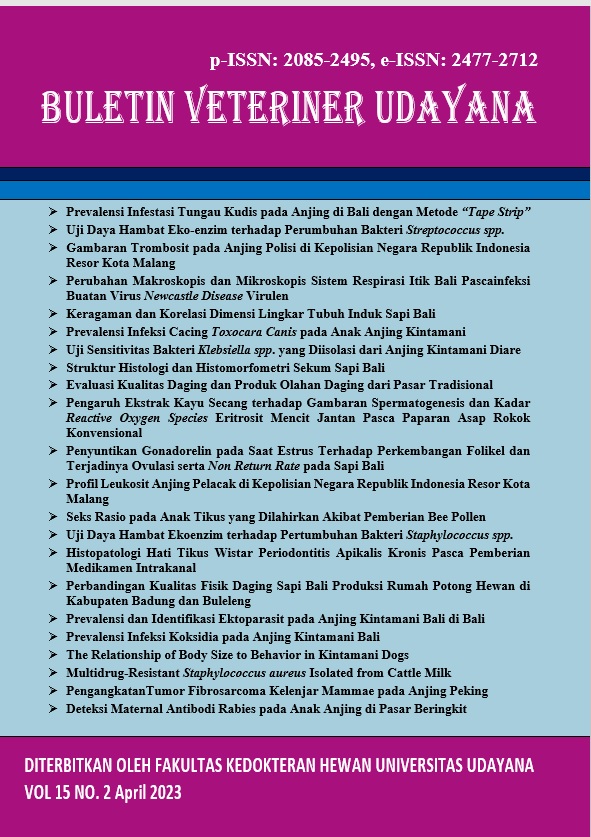PREVALENCE OF MANGE MITE INFESTATION ON DOGS IN BALI BY TAPE STRIP METHOD
Abstract
Mange is a disorder of the skin that can cause displeasure and changes in the skin. Scurvy is caused by Sarcoptes scabiei and Demodex spp. The number of dermatitis events in dogs is caused by maintenance management by removing which may be able to contact with dogs with mange. The purpose of this study was to find out the prevalence of mange mite infestations, the type of mite, and its relationship to risk factors that influence infestations in dogs in Bali. The number of study samples was 100 dogs in Bali that showed clinical symptoms in the form of disobedience which was distinguished by age, race, gender, and way of maintenance. The dog selected as a diselotip sample is then examined with a microscope to identify the mites. A dog sample tests positive if at least one mite is found. The results showed the prevalence of mange mites in dogs in Bali was 22% consisting of Sarcoptes scabiei 10% and Demodex spp. 12%. Further identification found Demodex canis with a prevalence of 7% and Demodex cornei 5%. The Chi-square test found that age and way of maintenance had a prevalence relationship between mite infestations, while gender and race were not associated with the prevalence of mite infestations. In connection with the large prevalence, serious attention is needed for dogs kept in Bali, especially regarding skin hygiene and health.
Downloads
References
Bagja W. 2020. Problema over populasi anjing dan kucing di Indonesia. No Strays Pawject.
Bantolo. 2019. Anjing kintamani bali diakui sebagai anjing ras dunia. https://www.agrofarm.co.id/2019/04/anjing-kintamani-bali-diakui-sebagai-anjing-ras-dunia/
Chee JH, Kwon JK, Cho HS, Cho KO, Lee YJ, Abd El-Aty AM, Shin SS. 2008. A survey of ectoparasite infestations in stray dogs of Gwang-ju City, Republic of Korea. Korean. J. Parasitol. 46(1): 23-27.
Chen YZ, Liu GH, Song HQ, Lin RQ, Weng YB, Zhu XQ. 2014. Prevalence of Sarcoptes scabiei infection in pet dogs in Southern China. Sci. World J. 2014.
Dharma IPPN, Oka IBM, Dharmawan NS. 2017. Prevalensi infeksi cacing ancylostoma spp. pada anjing di kawasan wisata di bali. Indon. Med. Vet. 6(3): 230-237.
Gunaseelan L, Bhavya S, Senthilkumar K, Balachandran C. 2011. Influencing factors for mange mite infestation of dogs in Chennai city. J. Vet. Anim. Sci. 7(5): 247-249.
Izdebska JN. 2010. Demodex spp. (Acari, Demodecidae) and demodecosis in dogs: Characteristics, symptoms, occurrence. Bul. Vet. Inst. Pulawy. 54(3): 335-338.
Kalyan S, Borthakur SK, Kalita G. 2005. Incidence of mange mite infestation in dogs-A report. J. Vet. Parasitol. 19(2): 147-148.
Khairiyah K. 2011. Zoonosis dan upaya pencegahannya (kasus Sumatera Utara). Bali Pengkajian Teknologi Pertanian Sumatera Utara. J. Litbang Pertanian. 30(3): 117-124.
Kumar A, Das AK, Sinha M, Arya SK, Kumar A, Kumar B. 2018. Study on the prevalence of demodectic mange in dogs in and around Patna. Int. J. Curr. Microbiol. Appl. Sci. 7: 4216-4221.
Latif A. 2001. Studi kasus pada anjing di Rumah Sakit Hewan Jakarta periode Januari 1999-Juli 2000. Skripsi. Fakultas Kedokteran Hewan. Institut Pertanian Bogor.
Oka IBM, Dwinata IM, Arjana AA. 2017. Prevalence and Identification of Dogs Scabies in Denpasar. Proc. International Seminar Studies on Bali Dog: Genetics, Culture, Diseases, Zoonoses and Community Health. Denpasar, Bali, 31 March–1 April 2017. Pp. 170-174.
Pereira DT, Castro LJM, Centenaro VB, Amaral AS, Krause A, Schmidt C. 2015. Skin impression with acetate tape in Demodex canis and Scarcoptes scabiei var. vulpes diagnosis. Arq. Bras. Med. Vet. Zootec. 67(1): 49-54.
Sampurna IP, Nindhia TS. 2008. Analisis data dengan SPSS, dalam rancangan percobaan. Udayana University Press. Denpasar.
Sardjana IKW. 2012. Pengobatan demodekosis pada anjing di Rumah Sakit Hewan Pendidikan Fakultas Kedokteran Hewan Universitas Airlangga. Vet Med. J. Klin. Vet. 1(1): 9-14.
Satria J. 2017. Prevalensi infestasi tungau kudis pada anjing di kawasan wisata di Bali. Skripsi. Fakultas Kedokteran Hewan Universitas Udayana.
Shresth D, Thapa B, Rawal G, Dhakal S, Sharma B. 2015. Prevalence of demodectic mange in Canines of kathmandu valley having skin disorder and its associated risk factors. Int. J. Appl. Sci. Biotechnol. 3(3): 459-463.
Sungkar S. 2016. Skabies: etiologi, patogenesis, pengobatan, pemberantasan dan pencegahan. Badan Penerbit Fakultas Kedokteran Universitas Indonesia.
Timur NPVT, Putriningsih PAS, Puja IK. 2015. Prevalence of skin disorders in Kintamani dog prevalensi gangguan kulit pada anjing kintamani. J. Ilmu Kes. Hewan. 3(1): 5-9.
Wardhana AH, Joses M, Tolibin I. 2006. Skabies tantangan penyakit zoonosis masa kini dan masa datang. Balai Penelitian Veteriner, Bogor. Wartazoa. 16(1): 40-52.
Wiryana IKS, Damriyasa IM, Dharmawan NS, Arnawa KAA, Dianiyanti K, Harumna D. 2014. Kejadian dermatosis yang tinggi pada anjing jalanan di Bali. J. Vet. 15(2): 217-220.





